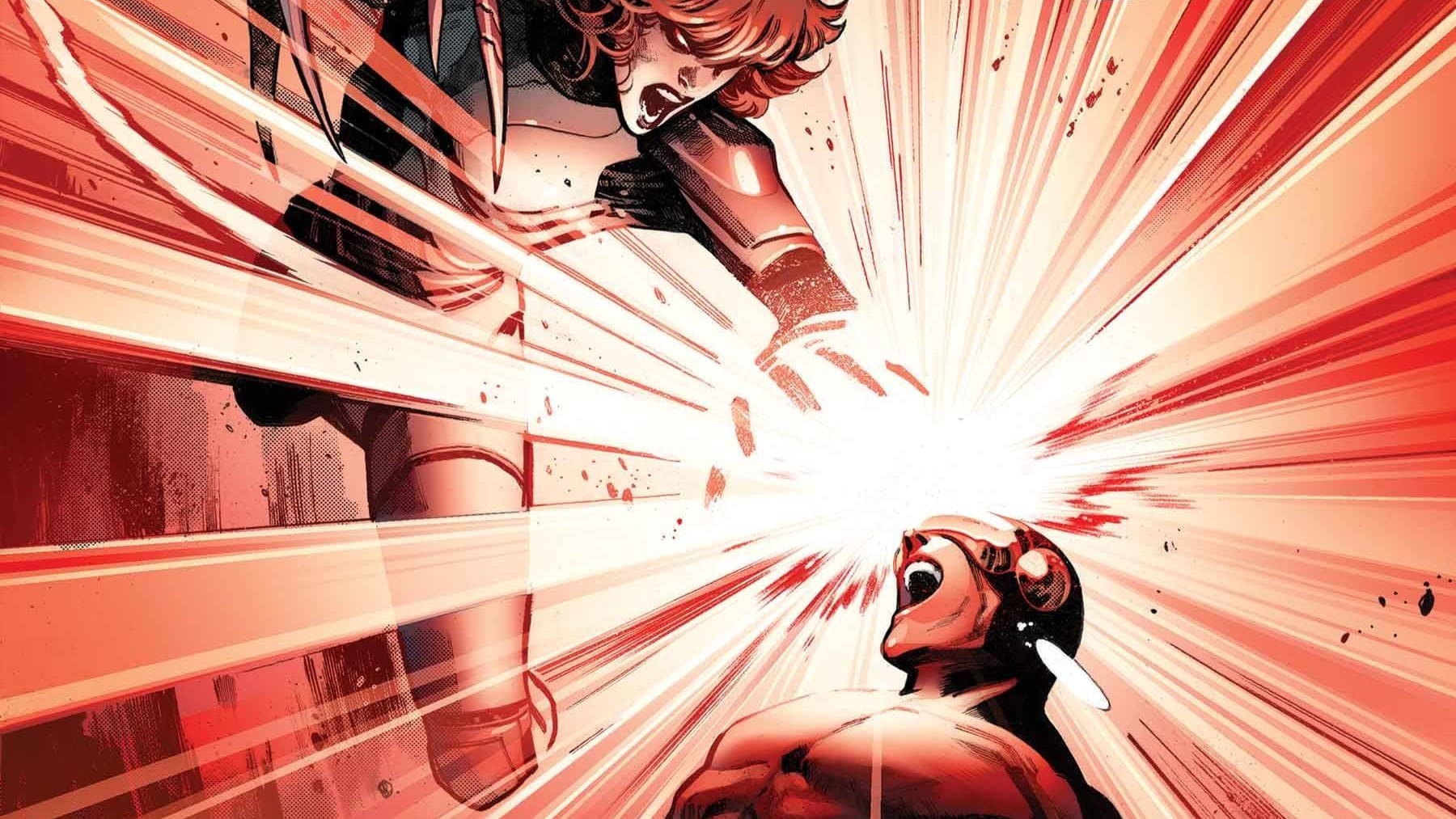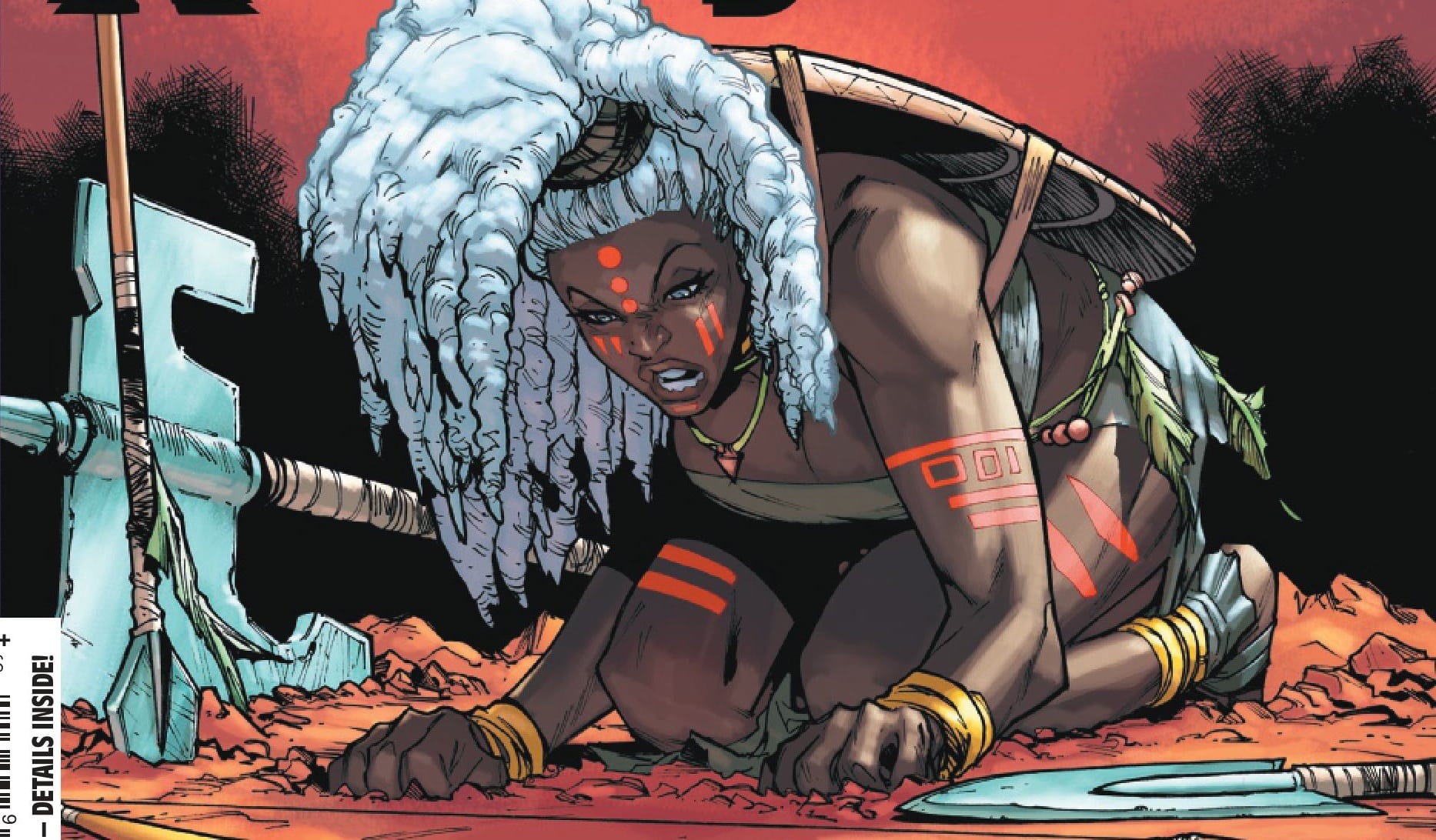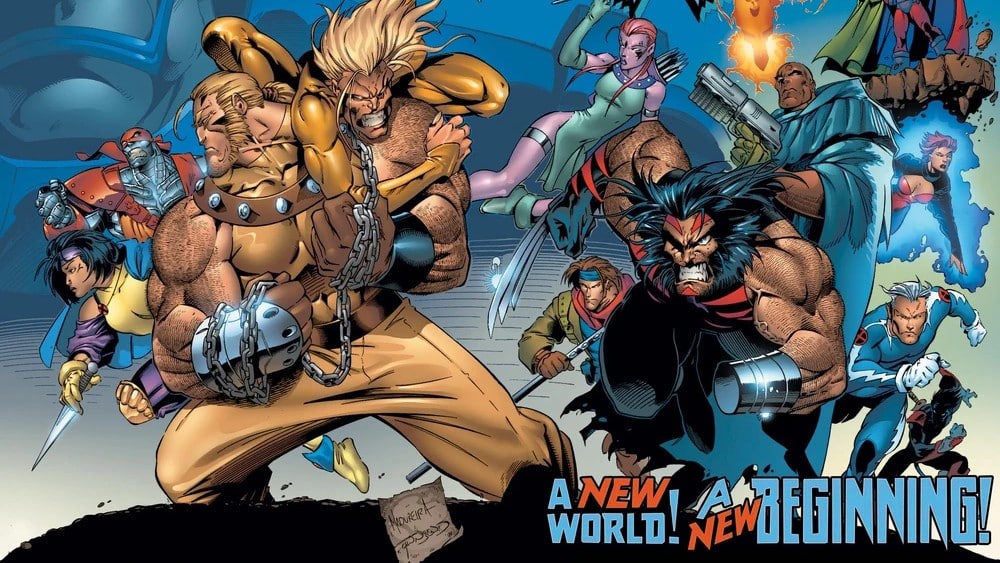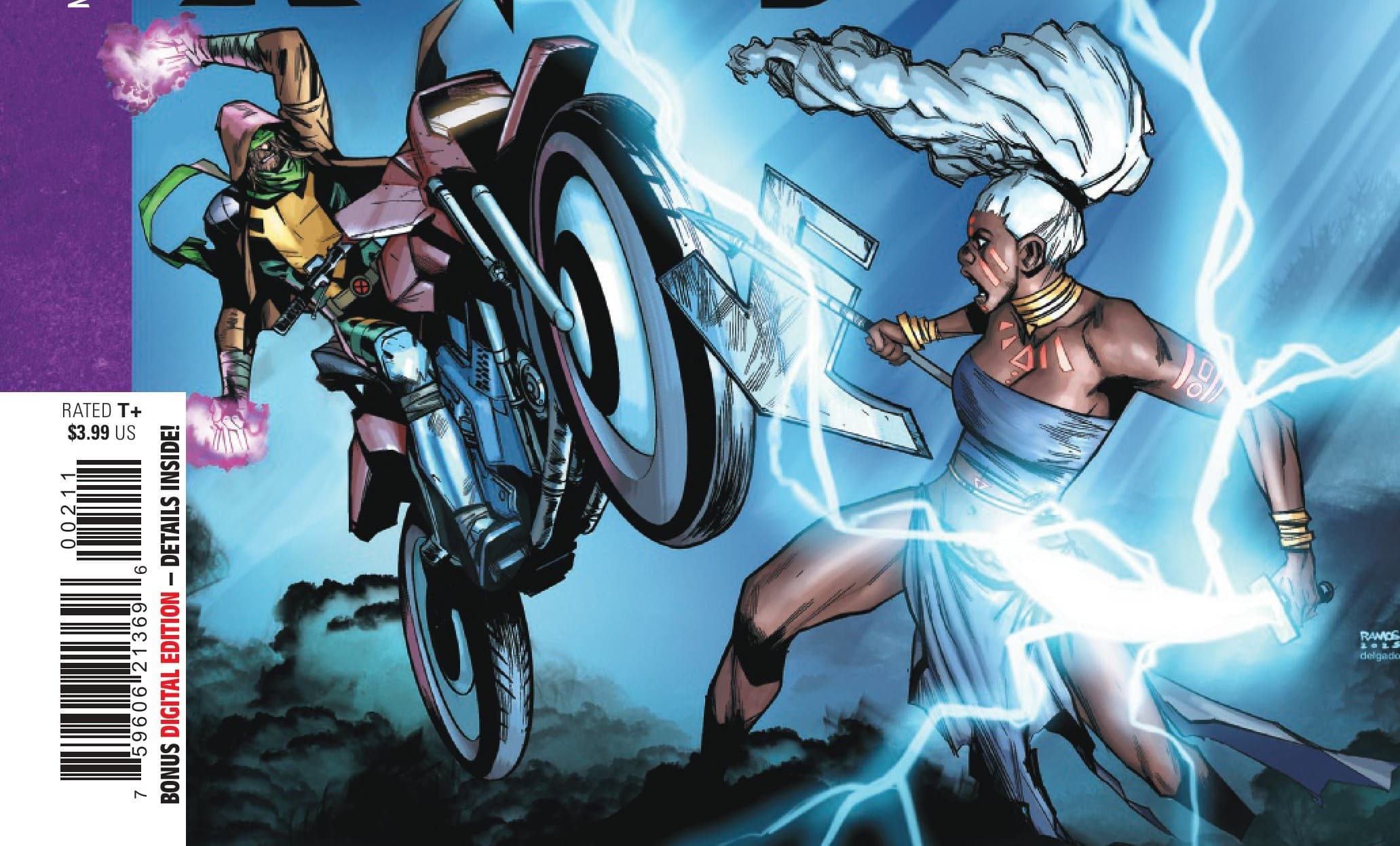The X-Men don’t play softball but do play hardball in the latest, bloodiest installment of the ongoing end of an era. Fall of the House of X #4 written by Gerry Duggan, drawn by Lucas Werneck and Jethro Morales, colored by Bryan Valenza, and lettered by VC’s Travis Lanham.
Anna Peppard: We all know baseball was (apocryphally) created by Abner Doubleday in 1839 at Cooperstown, New York. Softball, a closely related but importantly distinct sport, was created on Thanksgiving Day, 1887, at the Farragut Boat Club in Chicago, by folks using improvised materials to kill time while waiting on the results of a Yale-Harvard football match. Reporter George Hancock quickly patented the sport, introducing a larger, softer ball and a smaller bat that allowed it to be played both indoors and outdoors.
These key differences endure. The circumference of a softball is between 11.88-12.13 inches, while a baseball measures between 9.00-9.25 inches. And softball bats can be a maximum of 34 inches with 2.25 inch barrels, while baseball bats can be up to 42 inches with 2.61 inch barrels. The softball field of play is also smaller; a softball diamond has a maximum of 60 feet between bases, while a baseball diamond has a maximum of 90 feet. But perhaps the most noticeable difference is the style of pitching. Softballers pitch underhand, while baseball pitchers throw overhand. This final difference is easily observed in both real life and funnybooks, such as those starring Marvel’s formerly merry mutants, the sometimes-uncanny X-Men, who famously play baseball, not softball.
Anyway, this doesn’t really matter. Not to this comic, anyway, in which an important emotional showdown between famed mutant leader/jerk Professor Charles Xavier and his equally famous mentee/murderer Scott Summers occurs against the backdrop of what Scott refers to as the “softball field” on the grounds of Chuck’s former mansion, sometimes called Xavier’s School for Gifted Youngsters. But it kinda matters to me, as yet more evidence of this series’ sickeningly shallow emotional beats, scattered like misfired buckshot amid a barrage of careless bombast.
All of which is a fancy way of saying that for the fourth time in four months, Fall of the House of X strikes out. But I’m determined to go down swinging, and so’s this month’s pinch hitter, the (my) one and only Adam Reck!
Adam Reck: Hello, you. I would like to go on the record that despite my childhood status as an “inside kid” — despite the fact that while my younger brother played little league baseball I could be found in the announcer’s booth introducing the players and eating Reese’s Pieces — I, lifetime X-Men aficionado Adam Reck, do know something that any X-Men fan worth their weight in adamantium knows: The X-Men do not play softball. They play baseball.
This is no offense to the equally challenging and demanding sport of softball, but simply put, the X-Men don’t play it. Never have. And even at its worst, most treacly call-back for nostalgia’s sake moments (cough cough X-Men Gold I’m looking at you) our mutants are throwing overhand pitches. Alas, our heroes might as well be referencing their time on the cricket pitch for all the sense it doesn’t make.
Were this our review of Faux Hawks #2, I would probably pull my punches and get back on my soapbox about rushed production timelines and editorial mandates and the like, and while those concerns still apply, today I am simply fed up with just how bad this series continues to be on every possible level. We’re joking around about the softball gaffe, but that could be because it’s a concrete error to hold onto in the midst of chaotic and confusing storytelling that — from the overly descriptive and frankly lazy script to the rushed and confusing artwork — is utterly incomprehensible at this point. So I’m glad to be here to talk about it because I finished this comic and honestly could not tell you what happened in most of it because it was so bad.
We might as well give it a shot though, so…play ball?
A Cold Crucible

Anna: The Crucible ritual was introduced way back in 2020, in X-Men #7. It remains one of the most talked-about issues of the Krakoa era, inspiring considerable critical attention and many impassioned personal responses. I’ve always had mixed feelings about it. While it worked quite well for many folks as a metaphor for queer identity, it struck me as a fairly disturbing metaphor for disability, reminding me of some of the darker thoughts I’ve had when dealing with chronic illness. But of course, the ritual’s ability to inspire such passionate, and often wildly different, responses is exactly why X-Men #7 is a good comic: it’s a complicated story that inspires and rewards thoughtful discussion.
Here, we see the Crucible ritual stripped of much — or perhaps all — of that nuance and complexity. |>A<| is just out here hacking folks to pieces because Krakoa is a vampire that needs mutant blood to live. This wasn’t my previous impression of how Krakoa worked? Mutant energy and mutant blood are not necessarily the same thing. But if this comic isn’t going to care about the difference between softball and baseball, it sure ain’t going to care about that.
Adam: At its best the Crucible reflected the enormous power of personal transformation and reclamation of one’s true self. The Crucible was a first step in the Hickman (and Howard) retconning of |>A<|’s lifelong goals into something loftier, with the purpose of mutant solidarity and strength. To die in the Crucible was to be reborn as the real you, the person you’d been denied. X-Men #7 was a truly beautiful issue. It made us rethink a villain and give mutants new cultural avenues to self-actualization.
In Fall, we’ve seen Krakoa reduced from a sprawling multi-hemisphere u(dys)topian landscape to a scrawny dying Groot running for its life through ambiguous landscapes. I couldn’t tell you where Krakoa is right now on the planet Earth. It does appear that when Rogue and Gambit threw the Arakki out the back of their space pickup to burn up in the atmosphere they landed precisely on Krakoa’s current location. Krakoa’s dying from not having enough mutant energy to suck up (I agree, the literal feeding of blood to the tree does seem outside Krakoa’s normal deal). So we get a new version of the Crucible: step right up and kill yourself in the name of the tree! Even the Arakki don’t look thrilled with this development.
Anna: The cultural element of the sacrifice is missing, as is the element of rebirth. The original Crucible was a thought experiment extending from the altered rules of the X-Men’s new status quo. This version is just about killing teenagers for cheap pathos and also the admission that at the end of the day, some mutants are more equal than others. Some mutants get to have names and missions and care about each other as people. Some are just cannon fodder for a story that’s determined to end, as brutally as possible.
Adam: Let’s talk about Wrongslide.
Anna: Do we have to?
Adam: Yes! Wrongslide is Rockslide who was resurrected after dying in Otherworld, making him not the Santo we know. He has a total of maybe 12 appearances, so I went to figure out when the heck he started talking in complete sentences, let alone poetically eulogizing his existence on this mortal plane. I had to go back to X-Men Red #4 from July of 2022 to find an encounter between Sunspot and Wrongslide where Al Ewing has the character adopt his name and speak on the profundity of being.
Since then, he’s largely been in the background. His last appearance was on Krakoa in Bishop: War College so it doesn’t really make sense for him to be among the Arakki unless Fall is ignoring that miniseries altogether (something something gates I guess? Don’t they not work?). It’s also a wild swing to make him the crux of this scene since I think most readers might have forgotten about him completely.
There’s a version of this that works, where we had more time with Wrongslide and why he’d be willing to sacrifice himself. What we get here feels very tossed off, sudden, and completely unearned. There’s no logic to the character being in the scene, and the Crucible metaphor is being stretched to its absolute thinnest.
Anna: Life requires death, Adam. What more do you need to know?
What Just Exploded?

Anna: Like a lot of over-educated people, I can be weirdly insecure about my intelligence, particularly when it comes to doing the thing I’ve spent more than ten years of my life studying to do, which is understanding how stories work. In service of trying to reassure myself that all my hard-earned skills have not suddenly atrophied, I re-read Fall of the House of X #4 comic at least five times trying to figure out who is exploding whom, what, when, and where. Unfortunately, I don’t feel particularly reassured. I’m not sure I completely understand what happened in this story.
Adam: I had the exact same reaction, because I have zero idea what actually happened. However, I did not feel stupid. I thought this comic was stupid for being so unclear.
Anna: Also, I’m not sure if artists Lucas Werneck and Jethro Morales understand what happened, either?
Witness the “above Earth” debriefing session, in which images of the crisscrossed Peak stations (along with what we’re told is the US military Space Force frigate Agnew) seem to be hastily added in the background of the scene in an effort to orient the reader. I think the image of the Peak stations is supposed to be a separate panel, an establishing shot showing that our heroes are on one of the stations? But the way the stations are drawn, overlapping the borders of what may or may not be a monitor, makes them look like they’re just little toy stations hovering above Emma Frost’s shoulder. I had to carefully backtrack from later scenes to figure out what the art was maybe trying to communicate. I still feel like I’m mostly guessing.
Adam: I, the reader, should never have to work this hard just to figure out where characters are in a scene. Throughout Fall of the House of X and its ancillary stories in X-Men, Dead X-Men, and Iron Man, I have constantly been asking myself — where the heck are we?
Anna: This is followed by two big explosions. I think one explosion is the Agnew exploding itself, and the other is one of the Peak stations exploding the Sentinel City by teleporting into it. But the first depends on readers accepting that a single officer on a military spacecraft has unilateral control of all the nukes?
Adam: As I know from watching multiple nuclear sub movies, it’s very easy to single-handedly reach over and smack a red button to launch some nukes. No keys, no codes, just smack that red button! Easy peazy.
Anna: The second explosion depends on a bit of overly wordy expository dialogue from Nimrod while he’s busy trying to murder mutants amid a messy conflagration that could be happening literally anywhere in space or time.
Adam: Nimrod! The X-Men’s greatest foe who can supercompute its evil plans so fast it . . . doesn’t kill Cyclops and mistimes blowing him up afterwards so Magik can save him?
Anna: It’s hard to fear the robo-apocalypse when its leader apparently has less computing power than a Texas Instruments graphing calculator.
Xavier’s Gambit (No, not that Gambit)

Anna: The supposed crux of this issue is the reveal that it looks like Xavier has sold out humanity to Orchis for the sake of mutant survival. This happens in a data page, which is… a choice.
Remember when data pages were used to playfully supplement the story rather than as info dumps for stuff they didn’t have time to draw? I’m assuming there’s some kind of additional twist to this bargain. But it’s hard to believe in that level of complexity, since the bargain itself doesn’t make a lot of sense. I don’t know why the robots whose sole mission is techno-domination would suddenly be okay with letting some non-robots survive. “Perhaps a garden menagerie on Earth would not violate my programming,” says Nimrod. But I’m pretty sure it would…? Elsewhere in the issue, we see Nimrod contemplating traveling to other “undiscovered” places just so he can keep killing stuff. Which, again, doesn’t seem in line with its programming?
Adam: Nimrod! The X-Men’s greatest foe who can supercompute its evil plans so fast it . . . forgets its entire master plan/mission statement and considers letting mutantkind live in peace?
I too am baffled at what Xavier’s “deal” is here or why Nimrod and co. would accept it. But at this point, the sci-fi stakes of the story have been completely derailed, since Rise of the Powers of X is handling most of the Dominion stuff. Would be great if I could remember what the heck Nimrod and Omega Sentinel are even up to at this point. Would be even better if I hadn’t read in Dead X-Men that Xavier had THREE plans because other than killing little kid Moira, I got nothing.
This issue expects you not only to know what Xavier’s bargain is, it expects you to know that it’s a trick? I guess? When things are being explained this thinly, and multiple books are adding to, and at times somewhat contradicting, what’s happening, I can only be increasingly befuddled. Which does bring us all the way back around to Xavier bringing Cyclops to the softball field. Which we all know is a baseball field, which we all know is something the Silver Age kids never played, which makes no freakin’ sense what even is this book?!?
Anna: Fall of the House of X #4 concludes with Storm tearing a “scream of vengeance” across the galaxy. I don’t know how much I want to get into this, because a lot depends on how Storm is characterized in the next issue. For now, let’s just say that when writing a powerful Black woman, it’s worth being thoughtful about how and when you depict that woman getting angry. There’s nothing inherently wrong with the concept; Storm’s anger is certainly justified. But ending the issue by teasing the spectacle of a Black woman’s anger doesn’t sit quite right with me. It’s a nice pinup, at least, with Storm’s physical and facial expression more resonant with determination and power than unbridled rage.
Adam: All I know is I’m completely adrift. This book has untethered me from any Krakoan era reality and sent me flying through the astral plane where I hope that one day a brave psychic warrior will claim me. As we continue to mourn the possibilities of this island experiment, it is truly sad that the ending of it is this rushed and largely incoherent mess. Readers deserved a better conclusion to the last five years, and instead, we are getting whatever this is. I guess a small comfort is that there is only one issue left of this mini and then we can finally move on.
X-Traneous Thoughts
- In case you were misled by Pepe Larraz’s terrific cover, Cyclops and Moira X do not battle it out in this issue. In fact, this issue is 100% Moira free. For kid-Moira, please see Rise of the Powers of X. For future-Moira, please see Dead X-Men.
- You can’t hear yourself scream in space because space is a vacuum. What Storm is screaming into isn’t space, and likewise because she’s in a little bubble, no one can hear her scream either.
- We didn’t talk much about the art in this review because we’ve already talked at length about how rushed it feels, and this issue is no exception. But credit where credit’s due, the opening splash page looking up at |>A<| wielding his blackly bloodied sword is bloody nice — but it would be better without the corny captions. Elsewhere, the captions are load-bearing. Here, they detract from an otherwise suitably-monumental image.
- Weird that Scott is mad at Xavier for buddying up with Orchis after he just became best friends forever with Dr. Gregor before she died.
- Manifold continues to be the X-Men’s personal taxicab despite his powerset being so much more than that, not to mention Destiny portending he would be the savior of the mutant race.
- How will the X-Men beat the unbeatable Nimrod? What will be the culminating conclusion of this convoluted cavalcade of chaos? Tune in May 22 to find out, I guess.







